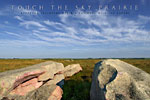By Dan Olson
Minnesota Public Radio
May 23, 2002
A sprawling prairie restoration project is underway in Minnesota and Iowa. The first remnant is near Luverne, the southwestern Minnesota hometown of photographer Jim Brandenburg. Brandenburg is famous for pictures of wolves and other images published on the pages of National Geographic magazine. As often as he can, he returns to Luverne where he has a gallery and a pet project. Brandenburg is working with the federal government to help reclaim the first piece of Northern Tallgrass Prairie Project in an area called the Blue Mounds.
| |
|
|
|
||
Bumping along in a car on a washboardy gravel road near the Luverne area farm where he grew up, Jim Brandenburg guesses white settlers named the area Blue Mounds because of the color they saw on the horizon.
"I think the early pioneers came rolling across these prairies in their covered wagons and from a distance they looked blue. We have the Sioux Quartzite that has kind of a purple look but from a distance that looks blue also when the lichens are on it especially," Brandenburg says.
Brandenburg has traveled the world for National Geographic photographic assignments. He makes his home near Ely in northeastern Minnesota. He returns often to visit an area he calls one of the world's most beautiful - the Blue Mounds in southwestern Minnesota.
A lot of prairie was destroyed by cows, grazing over the same plots of fenced-in pasture land, chewing the grass to the nub, allowing exotic species to take root. Settlers, desperate to claim another tillable acre to raise crops, tried to farm the Blue Mounds.
Brandenburg remembers his father's frustration at breaking plow share after plow share and then giving up trying to till the rock ridges.
"I always think of the Sioux Quartzite in a different way. It's protected a lot of prairie here," he says.
Jim Brandenburg's partner in prairie preservation is the U. S. Fish and Wildlife Service. Using public and private funds, they've bought about 600 acres of mostly pasture near Luverne. They've begun the years-long process of returning it to prairie. When restored, the land will once again support more than two hundred species of native prairie plants.
| |
|
|
|
||
Brandenburg, used to seeing the world through a view finder, likes the panorama atop the prairie rise. He enjoys telling visitors why some of the jagged quartzite rocks have rounded edges.
"I can see into Iowa and South Dakota. These little prominent ridges of Sioux quartzite were perfect rubbing stones for herds of bison over tens of thousands of years, and you'll find on corner where that bison could reach is polished as smooth as glass, and it's a wonderful place to be in inspired by the magnificence of the open country without trees," he says.
Southwestern Minnesota was once a piece in a huge biological mosaic - 142 million acres across 14 states of tall grass prairie. Biologists say it's the ecosystem closest to extinction on the planet. Less than one percent of the native prairie still exits in North America.
Brandenburg wants the prairie remnants to be used as a classroom. Standing in tall grass at Blue Mounds State Park near Luverne, Brandenburg says part of the project includes plots for school kids.
"They'll keep that same plot as a heritage to that class and so they'll learn about prairies at school and then in a general sense learn about prairies through the prairie learning center," he says.
Jim Brandenburg's photographs, including prairie scenes, hang in his gallery in Luverne. Money from sales of the pictures goes to support the Northern Tall Grass Prairie Heritage Preservation Area. When complete years from now, the area will be seventy seven thousand acres of remnants stretching across 85 counties in southwestern Minnesota and northwestern Iowa.
More Information

